SCHIZAEACEAE
Lygodium Sw.
Key to the Species

Lygodium flexuosum (L.) Sw., Schrad. J. Bot. 1800 (2): 106 (1801); Clarke (1880) 584; Bedd. (1883) 457, f. 283; H. Ito (1966) 455, (1971) 202; K. Iwats. (1975) 170. ——— Ophioglossum flexuosum L., Sp. Pl. 2: 1063 (1753).
TI 6304979~84, 725025, 725428, 770023, 771523, 771565~66, 771896, 773211, 774671, 8351579, Zimmermann 934, Polunin et al. 5712, Nicolson 2806, Kondo 758512, Tabata et al. 18518, 30475, 30483, 30621.
Climbing on shrubs or on branches of tall trees in open places or in semi-shaded places at lower elevations.
Ceylon, N India, Bhutan, SW and S China, Ryukyu, Taiwan, through Malesia and Melanesia to Queensland.
Lygodium japonicum (Thunb.) Sw., Schrad. J. Bot. 1800 (2): 106 (1801); Clarke (1880) 584; Bedd. (1883) 457; Hope, 15: 106 (1903); H. Ito (1966) 455; K. Iwats. (1975) 170. ——— Ophioglossum japonicum Thunb., Fl. Jap. 328 (1784).
TI 6300816, 6304985~89, 725037, 8350987, 8351051, Polunin 1315, Polunin et al. 3778, Namba et al. 55, 159, 304, 437, 495, Tabata et al. 14235, 18517, 18551, 30142.
On open grass fields or on mountain slopes in forests at low or middle elevation.
Ceylon, N India, Bhutan, China, Korea, Japan, Burma, Thailand, Indochina, throughout Malesia, east to New Guinea.
HYMENOPHYLLACEAE
Iwatsuki, K. 1985. The Hymenophyllaceae of Asia, excluding Malesia. J. Fac. Sci. Univ. Tokyo III, 13: 501-551. The system and specific concept in this literature are wholly accepted in the following enumeration.
Key to the Genera

Both Trichomanes and Cephalomanes are known from the Himalayan areas by T. bimarginatum, and C. obscurum and C. javanicum. These two genera are placed in the key to the genera, though I have seen no records of these genera from Nepal.
Hymenophyllum Sm.
Key to the Species
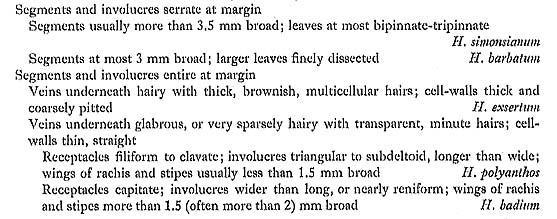
Hymenophyllum (Mecodium) levingei was recorded from Nepal in Ching & S.-K. Wu in C.-Y. Wu, Fl. Xizang. 1: 47 (1983).
Hymenophyllum simonsianum Hook., 2nd Cent. Ferns t. 13 (1860); Clarke (1880) 438; Bedd. (1883) 34; Copel., Phil. J. Sci. 64: 88 (1937); K. Iwats. (1966) 456, (1971) 203, (1975) 171, J. Fac. Sci. U. Tokyo III 13: 507 (1985).
TI 63-Oct.-29, 63-Nov.-12~13, 16, 63-Dec-2, 725171, 725324, Fleming 2029.
On mossy tree-trunks or on rocks in dense forests usually at 2000-3000 m alt.
N India, Bhutan, Yunnan, and Taiwan.
Hymenophyllum barbatum (v. d. B.) Baker in Hook. et Baker, Syn. Fil. 68
(1867); Copel., Phil. J. Sci. 64: 84, pl. 43 (1937); K. Iwats., J. Fac. Sci. U. Tokyo III 13: 507 (1985). ——— Leptocionium barbatum v. d. B., Ned. Kruid. Arch. 5: 416 (1863). Hymenophyllum denticulatum Sw. var. flaccidum (v. d. B.) Clarke (1880) 438, pl. 49, f. 2.
No specimens have been examined, though it is highly probable that it occurs in Nepal.
India, Bhutan, E and S China, Upper Burma, Thailand, Indochina, Taiwan, Japan, and Korea.
Hymenophyllum exsertum Wall. ex Hook., Sp. Fil. 1: 109, t. 38 A (1844); Clarke (1880) 436; Bedd. (1883) 30, f. 16; Hope, 13: 25 (1900); Copel., Phil. J. Sci. 64: 153, pl. 83 (1937); K. Iwats., J. Fac. Sci. U. Tokyo III 13: 513 (1985). ——— Mecodium exsertum (Wall. ex Hook.) Copel., Phil. J. Sci. 67: 23 (1938); K. Iwats. (1966) 457, (1971) 203, (1975) 171.
TI 63-Oct.-23~25, 27, 28, 30, 63-Nov.-2, 5, 8,13, 20, 23, 28, 63-Dec.-l, 4, 725098, 725128, 725170, 725326, 725493, 725895, 725940, 725949, 771712, 8330262, 8330289, 8580016, 8580057, 8580793, 8580915, Kanai s.n.
On tree-trunks or on mossy rocks in dense forests usually in montane or higher places.
Ceylon, India, Bhutan, SW to S China, Burma, Thailand, Indochina, and Malaya.
Hymenophyllum polyanthos (Sw.) Sw., Schrad. J. Bot. 1800 (2): 102 (1801); Clarke (1880) 436; Bedd. (1883) 30; Hope, 13: 25 (1900); Copel., Phil. J. Sci. 64: 97, pl. 46, 47 (1937); K. Iwats., J. Fac. Sci. U. Tokyo III 13: 516 (1985). ——— Tricho-manes polyanthos Sw., Prodr. Fl. Ind. Occ. 137 (1788). ——— Mecodium polyanthos (Sw.) Copel., Phil. J. Sci. 67: 19 (1938); K. Iwats. (1966) 457, (1971) 203, (1975) 171.
Hymenophyllum tenellum D. Don, Prodr. Fl. Nepal. 12 (1825).
Mecodium osmundoides (v. d. B.) Ching, Fl. Reip. Pop. Sin. 2: 147, pl. 10, f. 7-11 (1959); Ching & S.-K. Wu in C.-Y. Wu, Fl. Xizang. 1: 49 (1983).
TI 63-Oct.-24~25, 27~29, 63-Nov.-5, 11~14, 16~17, 21, 63-Dec.-l, 725100, 725129,725133, 725189, 725216, 725224, 725256, 725310, 725630, 725952, 770423, 8580067, 8580140, 8580149, 8580759, 8581003, 8581032, 8581172, 8581292, Kanai 16684.
On tree-trunks or on mossy rocks in shade or some open places in lowlands and up to 3500 m alt.
Cosmopolitan; a composite and variable species.
Hymenophyllum badium Hook. et Grev., Ic. Fil. t. 76 (1828); Copel., Phil. J. Sci. 64:144, pl. 76 (1937); K. Iwats., J. Fac. Sci. U. Tokyo III 13: 520 (1985). ——— Hymenophyllum javanicum Spr. var. badium (Hook. et Grev.) Clarke, (1880) 438; Bedd. (1883) 33. ——— Mecodium badium (Hook. et Grev.) Copel., Phil. J. Sci. 67: 23 (1938), K. Iwats. (1966) 457, (1971) 203, (1975) 171.
Hymenophyllum javanicum Spr. sens. Clarke (1880) 437; Bedd. (1883) 32.
TI 63-Nov.-19, 725325, 771718, 771732.
On mossy tree-trunks or on moist rocks and cliffs in dense forests up to 2500 m alt.
N India, Bhutan, China, Burma, Thailand, Indochina, S Japan to Ryukyu, Taiwan, and throughout Malesia.
Crepidomanes (Presi) Presi
Key to the Species

Crepidomanes minutum (Bl.) K. Iwats., J. Fac. Sci. U. Tokyo III 13: 524 (1985). ——— Trichomanes minutum Blume, Enum. Pl. Jav. 223 (1828); Copel., Phil. J. Sci. 51: 148 (1933); Yoroi & Iwats., Acta Phytotax. Geobot. 28: 152 (1977). ——— Gono-cormus minutus (Bl.) v. d. B., Hymen. Jav. 7, pl. 3 (1861).
Trichomanes prolifenmi Blume, Enum. Pl. Jav. 224 (1828); Bedd. (1883) 39.
Trichomanes diffusimi Blume, Enum. Pl. Jav. 225 (1828); Copel., Phil. J. Sci. 51: 149 (1933). ——— Gonocormus diffusus (Bl.) v.d. B., Hymen. Jav. 9, t. 4 (1861); K. Iwats. (1966) 456.
Trichomanes saxifragoides Presl, Hymen. 39, 131 (1843); Sledge, J. Linn. Soc. Bot. 60: 298 (1968).
Trichomanes parvulum auct. non Poir. (1808); Bedd. (1883) 39, f. 18.
TI 63-Nov.-13.
On moist rocks or on basal tree-trunks forming moss-like colonies in forests up to 2000 m alt.
Species delimitation is difficult; in the broader sense this species is known throughout the Old World.
Crepidomanes schmidtianum (Zenker ex Taschn.) K. Iwats., J. Fac. Sci. U. Tokyo III 13: 526 (1985). ——— Trichomanes schmidtianum Zenker ex Taschn., Dis-scrt. 34, pl. 1, f. 1, 3, 5 (1843); Copel., Phil. J, Sci. 51:135, pl. 2, f. 1 (1933).
Trichomanes latifrons v. d. B., Ned. Kruid. Arch. 5: 56, 209 (1863); Copel., Phil. J. Sci. 51: 139, pl. 4(1933).
Vandenboschia titibuensis H. Ito, J. Jap. Bot. 24: 125, f. 1 (1949); K. Iwats. (1975) 172.
Trichomanes pyxidiferum L. sens. Clarke (1880) 441; Bedd. (1883) 42; Hope, 12: 26 (1900).
TI 725140, 725176, 725349, 8581447.
On moist perpendicular surfaces of rocks in shade at 2000-3600 m alt.
N India, Bhutan, SW China, Japan, and Taiwan.
As the size and form of leaves are quite variable, two varieties are recognized by Iwatsuki (1985); the Nepalese plants are also variable, though the above materials are placed in var. schmidtianum.
Crepidomanes auriculatum (Bl.) K. Iwats., J. Fac. Sci. U. Tokyo III 13: 528 (1985). ——— Trichomanes auriculatum Blume, Enum. Pl. Jav. 225 (1828); Clarke (1880)442; Bedd. (1883) 44; Copel., Phil. J. Sci. 51: 223 (1933). ——— Vanden
boschia auriculata (Bl.) Copel., Phil. J. Sci. 67: 55 (1938); K. Iwats. (1966) 458, (1971) 203,(1975) 172.
TI 63-Oct.-23.
Climbing up trees or rarely on rocks in dense forests in lowlands up to 2200 m alt.
N India, Bhutan, Burma, Thailand, Indochina, SW China, S Japan, Ryukyu, Taiwan, and throughout Malesia.
Crepidomanes radicans (Sw.) K. Iwats. var. naseanum (Christ) K. Iwats., J. Fac. Sci. U. Tokyo III 13: 530 (1985). ——— Trichomanes naseanum Christ, Bull. Soc. Bot. Fr. 52 Mém. 1:11 (1905).
Trichomanes radicans Sw., Schrad. J. Bot. 1800 (2): 97 (1801); Clarke (1880) 441; Bedd. (1883) 43, p.p. excl. type; Copel., Phil. J. Sci. 51: 213, pl. 35, f. 1, 2 (1933). ——— Vandenboschia radicans (Sw.) Copel., Phil. J. Sci. 67: 54 (1938), p.p. excl. type; K. Iwats. (1966) 458, (1971) 203, (1975) 172.
TI 63-Dec.-4.
On muddy rocks usually along streams or on moist surfaces of cliffs in deep shade in forests.
N India, Bhutan, China, Korea, Japan, Ryukyu, Taiwan, Indochina, Thailand, Burma, and Malesia.
Crepidomanes birmanicum is known from Himalayan regions and is probably in Nepal.
Crepidomanes latealatum (v. d. B.) Copel., Phil. J. Sci. 67: 60 (1938); K. Iwats. (1966) 456, (1971) 202, (1975) 171. ——— Didymoglossum latealatum v. d. B., Ned. Kruid. Arch. 5: 138 (1863); Copel., Phil. J. Sci. 51: 192, pl. 25, 26 (1933).
Didymoglossum insigne v. d. B., Ned. Kruid Arch. 5: 143 (1863). ——— Trichomanes insigne (v. d. B.) Bedd., Ferns Br. Ind. pl. 284 C (1868). ——— Trichomanes bipunctatum Poir. var. insigne (v. d. B.) Bedd. (1883) 42. ——— Crepidomanes insigne (v. d. B.) Fu, Ill. Handb. Chin. Pl. Pterid. 39 (1957); K. Iwats. (1975) 171.
Crepidomanes sp.; K. Iwats. (1966) 456, (1971) 202.
Trichomanes filicula Bory; Hope, 13: 26 (1900).
TI 63-Oct.-24~25, 63-Nov.-5, 19, 20, 23, 63-Dec.-2, 67-25122, 725073, 725348, 725416, 725499, 725519, 8330259,8332095,8350174, 8580018,8580747, 8580756.
On tree-trunks, mossy rocks, or mossy cliffs in forests.
A composite species; the range of distribution is not clear.
CYATHEACEAE
Cyathea Sm.
Holttum, R. E. 1965. Tree-Ferns of the genus Cyathea Sm. in Asia (excluding Malaysia). Kew Bull. 19: 463-487.
Key to the Species

Cyathea chinensis Copel., Phil. J. Sci. Bot. 3: 355 (1909); Holtt., Kew Bull. 19: 466 (1965); K. Iwats. (1975) 180.
Cyathea brunoniana (Hook.) Clarke (1880) 430, excl. basion. ——— Amphicosmia brunoniana (Hook.) Bedd. (1883) 10, excl. basion. ——— Cyathea brunoniana (Hook.) Clarke et Baker sens. Tagawa (1966) 470.
No specimens are represented from Nepal.
In forests usually at 1000-2000 in alt. in Himalayan region.
N India, Bhutan, Yunnan, Upper Bruma, N Thailand, and Indochina.
Cyathea spinulosa Wall. ex Hook., Sp. Fil. 1: 25, t. 12 C (1844); Clarke (1880) 429, pl. 49, f. 1; Bedd. (1883) 6, f. 3; Holtt., Kew Bull. 19: 471 (1965); Tagawa (1966) 470; K. Iwats. (1971) 208, (1975) 180.
TI 63-Nov.-4, 725425, 771676, 771810, Suehiro 329, 342.
In dense moist forests usually at 100-2000 m alt.
N India, Bhutan, SW and S China, Burma, N Thailand, Japan, Ryukyu, and Taiwan.
Cyathea gigantea (Wall. ex Hook.) Holtt., Gard. Bull. S. S. 8: 318 (1935), Kew Bull. 19: 476 (1965); Tagawa (1966) 470. ——— Alsophila gigantea Wall. ex Hook., Sp, Fil. 1: 53 (1844).
Alsophila glabra Hook. sens. Clarke (1880) 433; Bedd. (1883) 14.
TI 63-Dec.-9, Kanai 12205.
Among bush in or on edges of forests at lower elevation usually up to 1200 m alt.
Ceylon, India, S and SW China, Burma, Thailand, Indochina, and W Malesia.
DICKSONIACEAE
Cibotium Kaulf.
Cibotium barometz (L.) J. Sm., Lond. J. Bot. 1: 437 (1842); Bedd. (1883) 24, f. 8. ——— Polypodwrn barometz L., Sp. Pl. 2: 1092 (1753).
This is known from the Himalayas, though there is no actual record of specimens from Nepal.
DENNSTAEDTIACEAE
Key to the Genera

Dennstaedtia Bernh.
Key to the Species
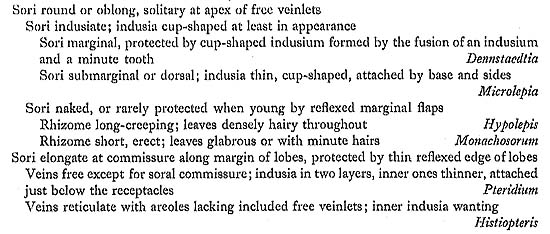
Dennstaedtia appendiculata (Wall. ex Hook.) J. Sm., Hist. Fil. 265 (1875); Bedd. (1883) 26, f. 15; H. Ito (1966) 462, (1971)204; K. Iwats. (1975) 174. ——— Dicksonia appendiculata Wall. ex Hook., Sp. Fil. 1: 79 (1844); Clarke (1880) 436; Hope, 13: 28 (1900).
TI 6300819, 63-Nov.-8~9,11, 69-June-6, 725007, 725097, 725317, 725489, 772147, 773086, 8310157, 8330085, 8350038,8580014, 8580837, Polunin et al.357,5264, 5432, Nishioka 186, Kanai et al. 62, 672864, Suehiro 107~114, 397, 400~401,465~466, 469~470, 637~640, 731, 816~817, 860, 872, 875~876, 2203, 2309, 2312~14, 2332, 2337, Namba et al. 435, 846, Tabata et al. 13602, 13745, 13776, 14167, 14705, 16863, 17022,17287, 18101, 18147,18710, 21813, 21879, 22825, 24395, 24913.
Terrestrial in the grassy fields or on edges of forests, most common at 1700-2500 m alt.
N India, Bhutan, and Sichuan.
Dennstaedtia scabra (Wall. ex Hook.) Moore, Ind. Fil. 307 (1861); Bedd. (1883) 24, f. 12; H. Ito (1966) 462; K. Iwats. (1975) 174. ——— Dicksonia scabra Wall. ex Hook., Sp. Fil. 1: 80 (1844); Clarke (1880) 436; Hope, 13: 28 (1900).
TI 63-Oct.-26~27, 63-Nov.-2~3, 28, 30, 725124, 725335, 725459, 8580948, 8580950, Fleming 1533.
On mountain slopes in semi-shaded places or in forests.
Ceylon, N India, Bhutan, Burma, Thailand, Indochina, C and S China, S Korea, Japan, Taiwan, Philippines, Malaya, Borneo, and Sulawesi.
Microlepla Presl
Key to the Species
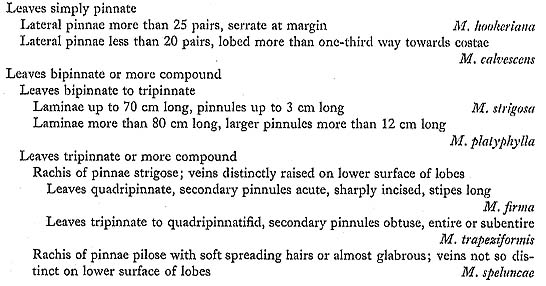
Microlepia hookeriana (Wall. ex Hook.) Presl, Epim. Bot. 95 (1849); Bedd. (1883) 62, f. 32; Ching, Fl. Reip. Pop. Sin. 2: 211, pl. 19, f. 1-5 (1959). ——— Davallia hookeriana Wall. ex Hook., Sp. Fil. 1: 172, t. 47 B (1846); Clarke (1880) 446.
Ching recorded the area of this species to include Nepal, though I have seen no specimens from there.
N India, Upper Burma, S China, Tonkin, Ryukyu, Taiwan, and W Malesia.
Microlepia calvescens (Wall. ex Hook.) Presl, Epim. Bot. 95 (1849). ——— Davallia calvescens Wall. ex Hook., Sp. Fil. 1: 172, t. 48 B (1846). ——— Davallia marginalis (Thunb.) Hook. et Baker var. calvescens (Wall. ex Hook.) Clarke (1880) 447. ——— Microlepia marginalis (Thunb.) Bedd. var. calvescens (Wall. ex Hook.) Bedd. (1883) 64.
Davallia scahra D. Don, Prodr. Fl. Nepal. 9 (1825).
Davallia marginalis (Thunb.) Hook. et Baker; Clarke (1880) 446. ——— Microlepia marginalis (Thunb.) Bedd. sens. Bedd. (1883) 64, p.p.
Microlepia marginata (Panzer) C. Chr. sens. H. Ito (1971) 205.
No specimens from Nepal have been examined.
On rather dry, humus-rich slopes in dense forests in the Himalayas.
N India, Upper Burma, S China, Tonkin, and Taiwan.
Microlepia strigosa (Thunb.) Presl, Epim. Bot. 95 (1849); Bedd. (1883) 67; H. Ito (1971) 205; K. Iwats. (1975) 75.Tricfiomanes strigosum Thunb., Fl, Jap. 339 (1784). ——— Dicksonia strigosa (Thunb.) Thunb., Trans. Linn. Soc. 2: 341 (1794); D. Don, Prodr. Fl. Nepal. 11 (1825).
Davallia polypodioides D. Don, Prodr. Fl. Nepal. 10 (1825); Clarke (1880) 447.
Microlepia todayensis Christ sens. H. Ito (1966) 463, p.p.
No specimens from Nepal.
On mountain slopes in or on edges of forests at 1000-2000 m alt. in the Himalayas.
Widely distributed in warmer parts of Asia and Oceania, Ceylon, and India to Polynesia, north to Japan.
Microlepia fmna Mett. ex Kuhn, Linnaca 36: 146 (1869); K. Iwats. (1975) 175.
Microlepia trapeziformis (Roxb.) Kuhn sens. H. Ito (1966) 463, (1971) 205.
TI 6305083,6305087.
On clayey slopes in dense forests at 1500-2200 m alt.
Ceylon, N. India, Bhutan, Upper Burma, N Thailand, and Yunnan.
Microlepia trapeziformis (Roxb.) Kuhn, Chactopt. 347 (1882); K. Iwats. (1975) 175. ——— Davallia trapeziformis Roxb., Calc. J. 4: 516 (1844).
Microlepia todayensis Christ sens, H. Ito (1966) 463, p.p.
TI 6305086, 771683, Kanai & Bista 12202.
On mountain slopes in or on edges of forests at 1400-2000 m alt.
Ceylon, N India, Bhutan, SW China, Thailand, Indochina, and W Malesia.
Microlepia speluncae (L.) Moore, Ind. Fil. 93 (1857); Bedd. (1883) 67; H. Ito (1966) 463, (1971) 205; K. Iwats. (1975) 175. ——— Polypodum spehmcae L., Sp. Pl. 2: 1093 (1753).
Davallia villosa D. Don, Prodr. Fl. Nepal. 10 (1825).
Davallia flaccida D. Don, Prodr. Fl. Nepal. 10 (1825); Clarke (1880) 448.
Davallia hirta Kaulf.; Hope, 13: 35 (1900).
TI 6305082, 63-Nov.-24, Dec-8, 725458, 771539, Kanai 16691, 671626, 674432, 674436, Tabata et al. 18593.
On rather dry, moderate slopes in open or semi-shaded places or on edges of forests at lower elevations lower than 1200 m alt.
Pantropics.
Microlepia platyphylla (D. Don) J. Sm., Lond. J. Bot. 1: 472 (1842); Bedd. (1883) 66, f. 33. ——— Davallia platyphylla D. Don, Prodr. Fl. Nepal. 10 (1825); Clarke (1880) 446; Hope, 13: 34 (1900).
Davallia solida (Forst.) Sw. sens. H. Ito (1966) 468, (1971) 207.
Wallich.
On wet ground commonly along streamlets in semi-shade.
Ceylon, N India, SW China, Thailand, Indochina, Taiwan, and Philippines.
Hypolepis Bernh.
Hypolepis punctata (Thunb.) Mett. ex Kuhn, Fil. Afr. 120 (1868); Bedd. (1892) 19; H. Ito (1966) 462, (1971) 205; K. Iwats. (1975) 174. ——— Polypodium punctatum Thunb., Fl. Jap. 337 (1784); Hope, 15: 81 (1903).
TI 6305068-73, 63-Oct.-13, 725041, 725371, 725496, 725885, 8330143, 8331494, 8331567, 8350128, 8580048, Polunin et al. 3751, Kanai 16690, Tabata et al, 18045.
On wet sandy slopes in open areas or in light shade at lower elevation.
N India to Japan, southwards to Malesia. Polynesian plants formerly referred to this are different.
Pteridium Gled. ex Scopoli
Pteridium aquilinum (L.) Kuhn in Deck., Reis. Ostafr. 3 (3) Bot, 11 (1879); Tryon, Rhodora 43: 22 (1941). ——— Pteris aquilina L., Sp. Pl. 2: 1075 (1753); Clarke (1880) 468; Bedd. (1883) 115; Hope, 13: 455 (1901).
var. wightianum (Wall.) Tryon, Rhodora 43; 22 (1941); H. Ito (1966) 465, (1971) 206; K. Iwats. (1975) 176.
Pteridium capense (Thunb.) Krasser var. densum (Wall.) Nakai, Bull. Nat. Sci. Mus. Tokyo 27: 5 (1949); Tagawa (1955) 78.
TI 6305115~19, 63-Dec.-4, 69-June-2, 725101, 725500, 725538, 725958, 771619, 8330151, 8580842, Polunin et al. 459, Biswas 9291, Chattcrjee 22, Nishioka 553, 563, Kanai et al. 16682, 673500, Suehiro 283-284, 2030, 2168, Namba et al. 838, 893, Tabata et al. 13604, 14115, 14811, 17079, 21058, 22754, 30055.
Usually growing in open areas commonly up to 3000 m alt.
Cosmopolitan.
Histiopteris (Ag.) J. Sm.
Histiopteris incisa (Thunb.) J. Sm., Hist. Fil. 295 (1875). ——— Pteris incisa Thunb., Prodr. Fl. Cap. 171 (1800); Clarke (1880) 471. ——— Lithobrochia incisa (Thunb.) Presi, Tent. Pterid. 149 (1836); Bedd. (1883) 120, f. 62.
This is recorded from Sikkim, Bhutan, and Khasi.
Terrestrial in semi-shade at 1300-2700 m alt.
Tropics and subtropics throughout the world.
Monachosorum Kunze
Monachosorum henryi Christ, Bull. Herb. Boiss. 6: 869 (1898); H. Ito (1966) 463, (1971) 205; K. Iwats. (1975) 176.
Polypodium subdigitatum Blume sens. Clarke (1880) 546, pl. 80, f.2. ——— Phegopteris subdigita.ta (Bl.) Bedd. (1883) 295, nom. sol.
TI 6305088-92, 6305220, 6310016~17, 725408.
On humus-rich mountain slopes in dense forests at 1500-2500 m alt.
N India, Bhutan, S and SW China, Indochina, and Taiwan.
LINDSAEACEAE
Kramer, K. U. 1972. The Lindsaeoid Ferns of the Old World VI Continental Asia, Japan and Taiwan. Gard. Bull. Sing. 26: 1-48.
Key to the Genera and Species
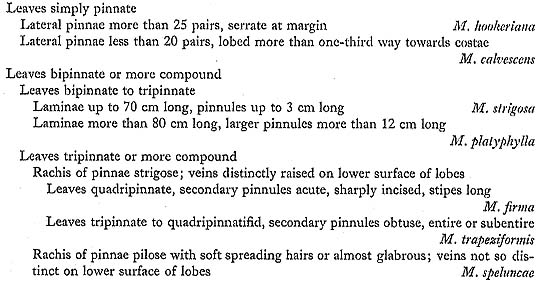
Lindsaea Dry.
Lindsaea ensifolia Sw., Schrad. J. Bot. 1800 (2): 77 (1801); Clarke (1880) 452; Kramer, Fl. Mal. II 1 (3); 211 (1971), Gard. Bull. Sing. 26: 32 (1972). ——— Schizoloma ensifolia (Sw.) J. Sm., J. Bot. 3: 414 (1841); Bedd. (1883) 80, f. 41.
(fide Kramer, 1972).
Widely distributed in the Old World tropics.
Of three subspecies recognized by Kramer, only the typical subspecies, subsp. ensifolia, is represented in Nepal.
Lindsaea orbiculata (Lam.) Mett. ex Kuhn var. commixta (Tagawa) Kramer, Fl. Mal. II 1 (3): 207 (1971), Gard. Bull. Sing. 26: 22 (1972). ——— Lindsaea commixta Tagawa, Acta Phytotax. Geobot. 6: 37, f. 3 H-J (1937).
(fide Kramer, 1972).
Terrestial on humus-rich floor of forests.
Ceylon, N India, S China, Burma, Thailand, Indochina, Japan, Ryuky, and Taiwan.
Lindsaea odorata Roxb., Calc. J. Nat. Hist. 4: 511 (1844); Kramer, Gard. Bull. Sing, 26: 40 (1972); K. Iwats. (1975) 175.
Lindsaea odorata Roxb. var. darjeelingensis Sen et Sen, Amer, Fern J. 61: 14, f. 1-8 (1971).
Lindsaea cultrata (Willd.) Sw. sens, Clarke (1880) 450; Bedd. (1883) 72, f. 36; H. Ito (1966) 463, (1971) 205.
TI 6305074~81, 725334, 725375, 771745, 8580818, Kanai 670698.
On moist rocks usually along streams in semi-open places at 1500-2500 m alt.
Tropics and subtropics of the Old World.
Only the typical variety, var. odorata, is represented in Nepal.
Sphenomeris Maxon
Sphenomeris chinensis (L.) Maxon, J. Wash. Acad. Sci. 3: 144 (1913); Kramer, Gard. Bull. Sing. 26: 4 (1972); K. Iwats. (1975) 178. ——— Davallia chinensis (L.) Sw.; Clarke (1880) 449. ——— Trichomanes chinensis L., Sp. Pl. 2: 1099 (1753). ——— Stenoloma chinensis (L.) Bedd. (1883) 70, f. 34.
Sphenomeris chusana (L.) Copel., Bull. Bishop Mus. 59: 69 (1929); H. Ito, (1966) 467. ——— Adiantum chusanum L., Sp. Pl. 2: 1095 (1753).
Davallia tenuifolia (Lam.) Sw., Schrad. J. Bot. 1800 (2): 88 (1801); Hope, 13: 35 (1900). ——— Adiantum tenuifolium Lam., Encycl. 1: 44 (1783).
Hymenophyllum ramosissimum Ham. ex D. Don, Prodr. Fl. Nepal. 12 (1825).
TI 6305178~79, 725374, 771578, 8350001, 8580878bis, 8580898, Kanai 670567, Tabata et al. 18550.
Terrestrial in open or semi-open places, or epiphytic in light shade at lower elevation up to 1200 m alt.
Tropics and subtropics of the Old World.
var. divaricata (Christ) Kramer is distinguished by the shape of the ultimate segments and the morphology of sori, and is actually recorded from Nepal, though the distinction of this variety from the type variety is not very clear.
DAVALLIACEAE
Kato, M. 1985. A systematic study of the genera of the fern family Davalliaceae. J. Fac. Sci. Univ. Tokyo III 13: 553-573.
Key to the Genera
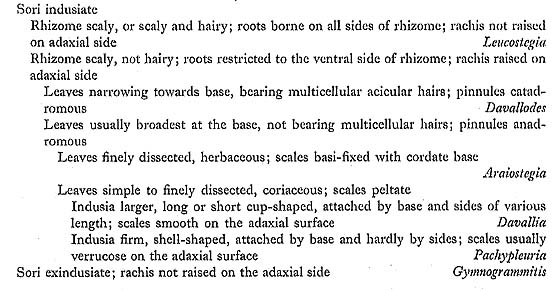
Pachypleuria is a renaming of Humata non Cav. (cf. Kato, 1985). Davallia griffithiana was referred to Humata, but is included here in Davallia.
Leucostegia Presi
Leucostegia immersa (Wall. ex Hook.) Presl, Tent. Pterid. 95, t. 4, f. 11 (1836); Bedd. (1883) 51; H Ito (1966) 469; K. Iwats. (1975) 179. ——— Davallia immersa Wall. ex Hook., Sp. Fil. 1: 156 (1846), Clarke (1880) 443; Hope, 13: 29 (1900).
TI 6305191~98, 63-Sept.-24, 725318, 725491, 725540, 725743, 771582, 771859, 772129, 858003, 8580718, Kanai 670450, Malla & Kanai 674617, Kanai et al. s.n., Suehiro 307~310, 932, 2023, 2160, Tabata et al. 19156, 19222.
Terrestrial on mountain slopes or in muddy crevices of rocks usually in dense Forests at 500-2500 m alt.
India, SW China, Burma, Thailand, Indochina, Taiwan, and Malesia.
Araiostegia Copel.
Key to the Species
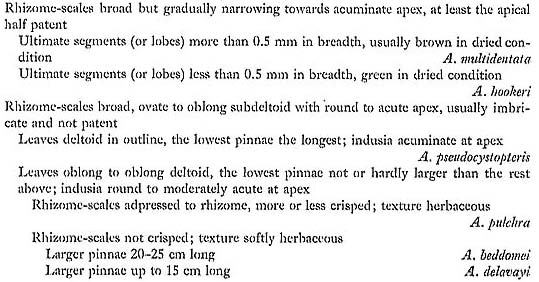
Araiostegia multidentata (Hook. et Baker) Copel., Phil. J. Sic. 34: 241 (1927); K. Iwats. (1975) 178. ——— Davallia multidentata Hook. et Baker, Syn. Fil. 91 (1867); Clarke (1880) 443. ——— Leucostegia multidentata (Hook. et Baker) Bedd., Ferns Br. Ind. Suppl. 4 (1876), (1883) 50.
Humata assamica (Bedd.) C. Chr. sens. H. Ito (1966) 469.
TI 6305188~90, 725341,725720, 725785, 725887, 771700, 8580006,8580878, Tabata et al. 18064.
On moist cliffs or on tree-trunks in forests at 1500-2500 m alt.
N India and SW China (Yunnan and Sichuan).
Araiostegia hookeri (Moore ex Bedd.) Ching, Fl. Reip. Pop. Sin. 2: 291 (1959); K. Iwats. (1975) 178. ——— Acrophoms hookeri Moore ex Bedd., Ferns Br. Ind. t. 95 (1865). ——— Leucostegia hookeri (Moore ex Bedd.) Bedd. (1883) 52.
Davallia clarkei Baker in Hook. cet Baker, Syn. Fil. ed. 2, 91 (1874); Hope, 13: 30, pl. 15 (1900). ——— Araiostegia clarkei. (Baker) Copel., Phil. J. Sci. 34: 241 (1927).
TI 725232, 8580039, Tabata et al. 15436.
On mossy tree-trunks in dense forests at 3000-3500 m alt.
N India and SW China (Tibet, Yunnan, and Sichuan).
Araiostegia pseudocystopteris (Kunze) Copel., Phil. J. Sci. 34: 241 (1927). ——— Davallia pseudocystopteris Kunze, Bot. Zeit. 1850: 68; Hope, 13: 31 (1900). ——— Lencostegia pseudocystopteris (Kunze) Bedd., Ferns Br. Ind. Suppl. 4 (1876), (1883) 54. ——— Davallia pulchra D. Don var. pseudocystopteris (Kunze) Clarke (1880) 444, pl. 49,f. 4.
Not actually collected in Nepal.
On tree-trunks or on mossy rocks in dense forests in the Himalayas.
N India, SW China, Upper Burma, and N Thailand.
Araiostegia pulchra (D. Don) Copel., Phil. J. Sci. 34: 241 (1927); Tagawa (1955) 79; H. Ito (1966) 468; K. Iwats. (1975) 179. ——— Davallia pulchra D. Don, Prodr Fl. Nepal. 11 (1825); Clarke (1880) 444. ——— Leucostegia pulchra (D. Don) J. Sm., Lond. J. Bot. 1: 426 (1842); Bedd. (1883) 52, f. 25.
Leucostegia pseudocystopteris (Kunze) Bedd.; Bedd. (1883) 54, p.p.
Araiostegia perdurans (Christ) Copel. sens. H. Ito (1966) 468.
Davallia trichomanoides Bl. sens. H. Ito (1971) 207.
TI 6305186, 63-Sept.-24, 725160, 725340, 725423~24, 725470, 725545, 725624, 725653, 725722B, 725846, 725901, 725924, 725937, 771504, 771555, 771864, 773062, 8331436, 8350098, 8580721, 8580803, 8581359, Nishioka 657, Nakao s.n., Kanai et al. s.n., Namba etal. 88, 130, Suehiro 171, 725, 2019, 2562, Tabata et al. 15385, 15471, 16969, 17587, 19219, 19440, 20155, 21170, 21228, 23304.
On mossy tree-trunks or on mossy rocks in dense forests at 1500-3000 m alt.
N India, Yunnan, Thailand, and Indochina.
Araiostegia beddomei (Hope) Ching, Fl. Reip. Pop. Sin. 2: 288 (1959). ——— Davallia beddomei Hope, 12: 527, pl. 1 (1899), 13: 33 (1900).
Not actually collected but highly probable to be in Nepal.
On tree-trunks in dense forests at middle elevation in N India.
N India and Yunnan.
Araiostegia delavayi (Bedd. ex Clarke et Baker) Ching, Fl. Reip. Pop. Sin. 2: 289 (1959); K. Iwats. (1975) 178, ——— Davallia pulchra D. Don var. delavayi Bedd. ex Clarke et Baker, J. Linn. Soc. 24: 410 (1888).
TI 725721, 725722A, 8331226, 8580158, 8580378, 8580658, 8580712, 8581325, Delavay, Namba et al. 1285, Tabata et al. 14669.
On mossy cliffs in semi-shade at 2000-2800 m alt., or rarely up to 4000 m alt.
N India and Yunnan.
Davallodes Copel.
Davallodes membranulosum (Wall. ex Hook.) Copel., Phil. J. Sci. 34:245 (1927); Ching, Fl. Reip. Pop. Sin. 2: 282, pl. 21, f. 7-8 (1959); K. Iwats. (1975) 179. ——— Davallia rnembranulosa Wall. ex Hook., Sp. Fil. 1: 158, t. 53A (1846); Clarke (1880) 442; Hope, 13: 29 (1900). ——— Leucostegia membranulosa (Wall. ex Hook.) J. Sm., Hist. Fil. 84 (1875); Bedd. (1883) 50. ——— Araiostegia membranulosa (Hook.) Holtt. ex T. et U. Sen & Holtt., Kew Bull. 27: 230 (1972).
TI 725388, 725889, 771700bis, 773301, 8330125, 8350160.
On mossy tree-trunks or on mossy rocks in dense forests at 1000-2000 m alt.
N India, Yunnan, N Thailand, and Tonkin.
Gymnogrammitis Griff.
Gymnogrammitis dareiformis (Hook.) Ching ex Tard. et C. Chr. in Lecomte, Fl. Gén. Indo-China 7 (2): 117 (1939). ——— Polypodium dareiforme Hook., 2nd Cent. Ferns t. 24 (1860); Bedd. (1883) 316, f. 169. ——— Davallia dareiformis (Hook.) Levinge ex Clarke (1880) 443. ——— Araiostegia dareiformis (Hook.) Copel., Univ. Calf. Publ. Bot. 12: 398 (1931); H. Ito (1966) 468; K. Iwats. (1975) 178.
TI 6305184, 725320, 725468, 725723, 771729, 771991, 774751, 8331635, 8580091, 8580753, Kanai et al. s.n.
On mossy tree-trunks or on wet mossy rocks in dense forests at 2300-2900 m alt.
Ceylon, N India, SW China, N Thailand, Tonkin, and Hainan.
Davallia Sm.
Davallia trichomanoides Blume, Enum. Pl. Jav. 238 (1828); H. Ito (1966)469; K. Iwats. (1975) 179.
Davallia bullata Wall. ex Hook., Sp. Fil. 1: 169, t. 50 B (1846); Clarke (1880) 445; Bedd. (1883)61,f.31.
TI 6305187, 725004, 725034, 8330109, Suehiro 149, 2035.
On tree-trunks often on high branches or on mossy rocks in dense forests at 800-1500 m alt.
Ceylon, India, Bhutan, Burma, Thailand, Indochina, and throughout Malesia.
Davallia griffithiana Hook., Sp. Fil. 1: 168, t. 49 B (1846); Clarke (1880) 445; Bedd. (1883) 60. ——— Humata griffithiana (Hook.) C. Chr., Contr. U.S. Nat. Herb. 26: 293 (1931); H. Ito (1971) 207.
Collected in Bhutan, on mossy tree-trunks in dense forests at middle elevation.
N India, Bhutan, Yunnan, and Taiwan.
OLEANDRACEAE
Key to the Genera

Nephrolepis Schott
Key to the Genera

Nephrolepis cordifolia (L.) Presl, Tent. Pterid. 79 (1836); Clarke (1889) 540; Bedd. (1883) 282, f. 144; Hope, 14: 748 (1903); Tagawa (1955) 79; H. Ito (1966)469, (1971) 208; K. Iwats, (1975) 179. ——— Polypodium cordifolium L., Sp. Pl. 2: 1089 (1753).
Aspidium auriculatum Wall. ex D. Don, Prodr. Fl. Nepal. 3 (1825).
Nephrodium edule D. Don, Prodr. Fl. Nepal. 5 (1825).
TI 6305199, 6305201, 69-June-6, 725046, 725876, 8330123, 8331400, 8350011, Namba et al. 485, Suehiro 2034, 2187, Tabata et al. 18039, 18563.
Terrestrial on mountain slopes, rocky ground, on muddy or dry rocks, or on tree-trunks in semi-shaded places at lower elevations up to 2000 m alt.
Pantropic, north to Japan and south to New Zealand.
Nephrolepis delicatula (Decne.) Pichi-Ser., Webbia 23: 181 (1968); K. Iwats. (1975) 179. ——— Nephrodium delicatulum Decne. in Jacq., Voy. Ind. Bot. 4: 178, t. 179 (1844).
No specimens from Nepal have actually been examined; on moist mossy rocks in mountain forests at low elevation in India.
India, Burma, Thailand, and Yunnan.
Oleandra Cav.
Key to the Species

Oleandra pistillaris (Sw.) C. Chr., Ind. Fil. Suppl. III, 132 (1934); K. Iwats. (1975) 179. ——— Aspidium pistillare Sw., Schrad. J. Bot. 1800 (2): 30 (1801).
Oleandra neriiformis Cav., Anal. Hist. Nat. 1: 115 (1799); Clarke (1880) 541; Bedd. (1883) 285, f. 146; H. Ito (1971) 208.
TI 6305202, 725378, 725514, Suehiro 126, Tabata et al. 19171.
On mountain slopes forming thickets on edges of forests at 1200-2500 m alt.
Thailand and W Malesia.
Oleandra wallichii (Hook.) Presl, Tent. Pterid. 78 (1836); Clarke (1880) 542; Bedd. (1883) 287, f. 147; Hope, 14: 749 (1903); H. Ito (1966) 469; K. Iwats. (1975) 180. ——— Aspidium wallichii Hook., Exot. Fl. t. 5 (1823).
Neuroria asplenioides D. Don, Prodr. Fl. Nepal. 7 (1825).
TI 6305203~08,6300810,725154, 725319, 725477, 725555,725881,725931, 771917, 773035, 8330190, 8331671, 8350121, 8580035, 8580934, Kanai 673328, Nishioka 812, Suehiro 331, 362, 723, 724, 788, Tabata et al. 18100, 19220.
On mossy tree-trunks or on rather dry mossy slopes in evergreen forests at 1000- 3000 m alt.
N India, Bhutan, SW China, Upper Burma, N Thailand, Tonkin, and Taiwan.
PARKERIACEAE
Key to the Genera

Ceratopteris Brongn.
Ceratopteris thalictroides (L.) Brongn., Bull. Soc. Phil. 1821: 186 (1822); Clarke (1880) 471; Bedd. (1883) 123, f. 63: Hope, 13: 458 (1901). ——— Acrostichiim thalictroides L., Sp. Pl. 2; 1070 (1753).
Ceratopteris siliquasa (L.) Copel., Phil. J. Sci. 56: 107 (1935); H. Ito (1966) 468. ——— Acrostichum siliquosum L., Sp, Pl. 2: 1070 (1753).
TI 6305180~83, 8331464, Fleming 1863.
Aquatic or subaquatic in paddy fields usually in open places below 1500 m alt.
Warmer regions throughout the world.
Actiniopteris Link
Actiniopteris semiflabellata Pichi-Ser., Webbia 17; 24, f. 4 (1962); H. Ito (1966) 458 ;K. Iwats. (1975) 172.
Actiniopteris dichotoma Forsk. sens. Clarke (1880) 505; Bedd. (1883) 197, f. 98.
Actiniopteris radiata Link sens. Hope, 14: 266 (1902).
TI 6300812, 6304992, 725049, 725512, 773142.
In crevices or on perpendicular surfaces of rocks in open places along the Tamur River at about 300 m alt.
Africa, Yemen, and Arabia.
Coniogramme Fée
Key to the Species


Coniogramme caudata (Presi ex Ettingsh.) Ching in C. Chr., Ind. Fil. Suppl. 3: 56 (1934); H. Ito (1966) 460, (1971) 204; K. Iwats. (1975) 173. ——— Gymnopteris caudata Presi ex Ettingsh., Farnkr. 57, t. 37, f. 7, t. 38, f. 3 (1865).
TI 6305032~40, 725110, 725372, 725492, 8330199, 8580761, Kanai 670752, Polunin et al. 3861, Suehiro 889, 945~46, Shiraiwa 4432, Tabata et al. 21536.
On humus-rich floor of forests at middle elevations.
N India, SW China (Tibet and Yunnan), and Upper Burma.
Coniogramme fraxinea (D. Don) Diels, Engl. Pflanzenfam. 1 (4); 262 (1899); H. Ito (1966) 461; K. Iwats. (1975) 174. ——— Diplazium fraxineum D. Don, Prodr. Fl. Nepal. 12 (1825). ——— Syngramme fraxinea (D. Don) Bedd. (1883) 386, f. 222. ——— Gymnogramma fraxinea (D. Don) Bedd.; Clarice (1880) 569.
Diplazium falcatum D. Don, Prodr. Fl. Nepal. 13 (1825).
Gymnogramma javanica Bl. sens. Hope, 15: 100 (1903).
Coniogramme affinis (Wall.) Hieron.; Tagawa (1955) 78; Ching & S.-K. Wu in C.-Y. Wu, Fl. Xizang. 1: 99 (1983).
TI 6305041~44, 725414, 725883.
On mountain slopes on edges of or in dense forests at lower to middle elevations.
Ceylon, India, SW China (Tibet and Yunnan), Burma, N Thailand, Indochina, Taiwan, and W Malesia.
Coniogramme intermedia Hieron., Hedw. 57: 301 (1916); H. Ito (1966) 461, (1971) 204; K. Iwats. (1975) 174.
TI 6305045~54, 725306, 725539, 8350292, 8350880, 8581293, Zimmermann 1749, Shiraiwa 4348, Tabata et al. 13857, 13969, 15470, 19113, 19822, 20231, 20769, 21097, 22819.
On mountain slopes in shade or on humus-rich floor of dense forests at middle elevations.
N India, China, Indochina, Korea, Japan, and Taiwan.
This is variable especially in the western Hymalayas and needs further studies.
Coniogramme procera F é e, M é m. Soc. Sci. Strasbourg 6 (1) 22 (1865); H. Ito (1966) 461; K. Iwats. (1975) 174.
TI 6300809, 6305055~65, 771717, 772676, 8350292, 8350319, 8580786, Zimmermann 1893, Suehiro 1069, Tabata et al. 14127, 21761, 21749, 24985.
On humus-rich mountain slopes in forests at middle elevations.
N India, N Thailand, Yunnan, and Taiwan.
Onychium Kaulf.
Key to the Species

Onychium siliculosum (Desv.) C. Chr., Ind. Fil. 468 (1906); H. Ito (1966) 464, (1971) 206; K. Iwats. (1975) 176.——— Pteris siliculosa Desv., Berl. Mag. 5: 324 (1811).
Onychium auratum Kaulf., Enum. Fil. 144 (1824); Clarke (1880) 458; Bedd. (1883) 96, f. 49; Hope, 13: 443 (1901).
TI 6305103, 6305105~08, 69-June-6, 725027, 725449, 725866, 770024, 771594, 8331472, 8331547, 8351016, Nakao s.n., Nishioka 1165, Namba et al. 29, 350, 493, 923004, Suehiro 47~49, 1567~69, Zimmermann 2108, Polunin et al. 5722, Tabata et al. 18056,18539.
On rather dry banks of new roads in open places usually less than 1000 m alt., but rarely up to 2000 m alt.
N India, Bhutan, Yunnan, Burma, Indochina, Taiwan, throughout Malesia, and Polynesia.
Onychium japonicum (Thunb.) Kunze, Bot. Zeit. 6: 507 (1848); Clarke (1880) 459; Bedd. (1883) 96; Hope, 13: 443 (1901); H. Ito (1966) 464, (1971) 206; K. Iwats. (1975) 176. ——— Trichomanes japonicum Thunb., Fl. Jap. 340 (1784).
Leptostegia lucida D. Don, Prodr. Fl. Nepal. 14 (1825). ——— Onychium japonicum var. 'luculum (D. Don) Christ, Bull. Soc. Bot. France 52, M é m. 1: 60 (1905); Ching, Lingn. Sci. J. 13: 497 (1934). ——— Onychium lucidum (D. Don) Spr., Syst. Veg. 4: 66 (1827); Ching & S.-K. Wu in C.-Y. Wu, Fl. Xizang. 1: 78 (1983).
TI 6305100~02, 67-1110, 67-2720, 725376, 8350002, 8580832, Kanai et al. 673563, 672767, Suehiro 2170~71, Tabata et al. 21880, 30045, 30214.
Terrestrial on rather dry slopes in forests at middle elevations.
N India, Bhutan, China, Burma, Korea, Japan, Taiwan, Philippines, and Java.
Onychium contiguum Hope, J. Nat. Hist. Soc. Bombay 13; 444 (1901); Tagawa (1955) 79; H. Ito (1966) 464; K. Iwats. (1975) 176.
Onychium japonicum (Thunb.) Kunze var. intermedia Clarke (1880) 459.
Onychium japonicum (Thunb.) Kunze sens. Bedd. (1883) 96, p. p.
TI 6305094~99, 725107, 725333, 725478, 8350403, 8580728, Polunin et al. 5434, Zimmermann 1658, Kanai 670029, 853282, Namba et al. 645, 1097, Nishioka 619, Nakao s.n., Tabata et al. 2936, 13612, 13772, 13952, 15386, 19438, 21047, 21061, 22827, 22988, 24987.
On rather dry mountain slopes in forests, commonly at 2400-3500 m alt.
N India, Tibet, Yunnan, Thailand, and Taiwan.
|

















